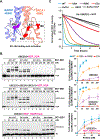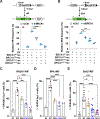Crucial roles of the BRCA1-BARD1 E3 ubiquitin ligase activity in homology-directed DNA repair
- PMID: 37797621
- PMCID: PMC10591799
- DOI: 10.1016/j.molcel.2023.09.015
Crucial roles of the BRCA1-BARD1 E3 ubiquitin ligase activity in homology-directed DNA repair
Abstract
The tumor-suppressor breast cancer 1 (BRCA1) in complex with BRCA1-associated really interesting new gene (RING) domain 1 (BARD1) is a RING-type ubiquitin E3 ligase that modifies nucleosomal histone and other substrates. The importance of BRCA1-BARD1 E3 activity in tumor suppression remains highly controversial, mainly stemming from studying mutant ligase-deficient BRCA1-BARD1 species that we show here still retain significant ligase activity. Using full-length BRCA1-BARD1, we establish robust BRCA1-BARD1-mediated ubiquitylation with specificity, uncover multiple modes of activity modulation, and construct a truly ligase-null variant and a variant specifically impaired in targeting nucleosomal histones. Cells expressing either of these BRCA1-BARD1 separation-of-function alleles are hypersensitive to DNA-damaging agents. Furthermore, we demonstrate that BRCA1-BARD1 ligase is not only required for DNA resection during homology-directed repair (HDR) but also contributes to later stages for HDR completion. Altogether, our findings reveal crucial, previously unrecognized roles of BRCA1-BARD1 ligase activity in genome repair via HDR, settle prior controversies regarding BRCA1-BARD1 ligase functions, and catalyze new efforts to uncover substrates related to tumor suppression.
Keywords: BARD1; BRCA1; DNA damage response; DNA end resection; HDR; histone; homology-directed repair; later stages for HDR completion; substrates; tumor suppression; ubiquitin E3 ligase.
Published by Elsevier Inc.
Conflict of interest statement
Declaration of interests D.N.I. is a co-founder and a shareholder of E3 Bioscience LLC, a commercial entity that manufactures FRET-active E2∼Ub conjugates used in this study.
Figures







References
-
- Petrucelli N, Daly MB, and Pal T (1998). BRCA1- and BRCA2-Associated Hereditary Breast and Ovarian Cancer. In GeneReviews((R)), Adam MP, Ardinger HH, Pagon RA, Wallace SE, Bean LJH, Stephens K, and Amemiya A, eds. [updated 2022 May 26].
-
- Hatchi E, Skourti-Stathaki K, Ventz S, Pinello L, Yen A, Kamieniarz-Gdula K, Dimitrov S, Pathania S, McKinney KM, Eaton ML, et al. (2015). BRCA1 recruitment to transcriptional pause sites is required for R-loop-driven DNA damage repair. Mol Cell 57, 636–647. 10.1016/j.molcel.2015.01.011. - DOI - PMC - PubMed
-
- Silver DP, and Livingston DM (2012). Mechanisms of BRCA1 tumor suppression. Cancer Discov 2, 679–684. 10.1158/2159-8290.CD-12-0221. - DOI - PMC - PubMed
Publication types
MeSH terms
Substances
Grants and funding
LinkOut - more resources
Full Text Sources
Medical
Research Materials
Miscellaneous

